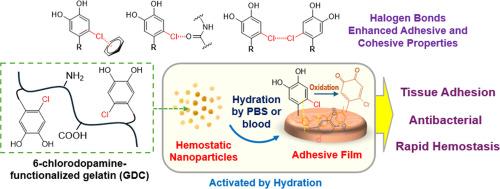氯儿茶酚功能化明胶纳米颗粒作为具有抗菌性能的止血剂。
IF 9.6
1区 医学
Q1 ENGINEERING, BIOMEDICAL
引用次数: 0
摘要
出血是与创伤相关的主要可预防的死亡原因之一,创伤往往并发伤口感染。目前的止血材料并不理想,缺乏预防感染所需的抗菌性能。在这里,我们测试了6-氯多巴胺功能化明胶(GDC)纳米颗粒作为具有强组织粘附性和抗菌性能的止血粉末的可行性。6-氯多巴胺含有一个儿茶酚侧链,该侧链被一个吸电子的氯原子进一步修饰,并具有很强的组织粘附性和抗菌性能。这些明胶纳米颗粒不是共价交联的,这使得它们在与水溶液或血液水合时能够迅速转化为粘附膜。儿茶酚的氯化作用显著提高了结构的完整性、与组织表面的界面结合以及膜形成的速度。此外,GDC纳米颗粒无细胞毒性和非溶血性,并有效杀死革兰氏阳性(表皮葡萄球菌、金黄色葡萄球菌)和革兰氏阴性(大肠杆菌)细菌。最后,与商业纤维蛋白胶Tisseel相比,GDC纳米颗粒在小鼠尾巴横断和肝出血模型中实现了显著更快的止血和减少失血。这些发现突出了GDC纳米颗粒作为一种多功能止血剂的潜力,能够快速控制出血和预防感染。意义声明:现有的止血剂通常缺乏有效的抗菌特性,可能不适合在院前环境中应用。这项工作评估了一种多功能止血纳米颗粒,通过一种简单的生物启发配方,解决了出血控制和感染预防的关键挑战。明胶纳米颗粒被氯八儿茶醇(GDC)功能化,当与血液水合时可以迅速转变成粘附膜。氯儿茶酚赋予纳米粒子很强的组织粘附性、膜完整性和抗菌性能。在小鼠出血模型中,与商业纤维蛋白密封剂相比,GDC显著减少了失血量和出血时间。这种粉末状材料不需要混合或专门的设备来部署,这使得它可能适合在院前环境中应用。本文章由计算机程序翻译,如有差异,请以英文原文为准。

Chlorocatechol-functionalized gelatin nanoparticles as a hemostatic agent with antimicrobial properties
Hemorrhage is one of the leading preventable causes of death associated with trauma, which is often complicated by wound infection. Current hemostatic materials are not ideal and lack antimicrobial properties needed for infection prevention. Here, we tested the feasibility for 6-chlorodopamine-functionalized gelatin (GDC) nanoparticles to function as a hemostatic powder with strong tissue adhesion and antibacterial properties. 6-Chlorodopamine contains a catechol sidechain that is further modified with an electron withdrawing chlorine atom, and provides strong tissue adhesion and antimicrobial property. These gelatin nanoparticles are not covalently crosslinked, which enablde them to rapidly transition into an adhesive film when hydrated with an aqueous solution or blood. The chlorination of catechol significantly increased structural integrity, interfacial bonding to tissue surface, and the rate of film formation. Additionally, GDC nanoparticles are noncytotoxic and nonhemolytic, and effectively killed Gram-positive (Staphylococcus epidermidis, Staphylococcus aureus) and Gram-negative (Escherichia coli) bacteria. Finally, GDC nanoparticles achieved significantly faster hemostasis and reduced blood loss when compared to a commercial fibrin glue, Tisseel, in tail transection and liver hemorrhage models performed in mice. These findings highlight the potential of GDC nanoparticle as a versatile, multifunctional hemostatic agent capable of both rapid hemorrhage control and infection prevention.
Statement of Significance
Existing hemostatic agents often lack effective antimicrobial properties and may not be suited for application in a prehospital setting. This work evaluated a multifunctional, hemostatic nanoparticle that addresses key challenges in hemorrhage control and infection prevention, through a simple, bioinspired formulation. Gelatin nanoparticles were functionalized with chlorocatechol (GDC) that can rapidly transition into adhesive films when hydrated with blood. Chlorocatechol imparted the nanoparticles with strong tissue adhesion, film integrity, and antimicrobial property. In mouse hemorrhage models, GDC significantly reduced blood loss and bleeding time when compared to a commercial fibrin sealant. This powder-form material requires no mixing or specialized equipment to deploy, which makes it potentially suitable for application in a prehospital setting.
求助全文
通过发布文献求助,成功后即可免费获取论文全文。
去求助
来源期刊

Acta Biomaterialia
工程技术-材料科学:生物材料
CiteScore
16.80
自引率
3.10%
发文量
776
审稿时长
30 days
期刊介绍:
Acta Biomaterialia is a monthly peer-reviewed scientific journal published by Elsevier. The journal was established in January 2005. The editor-in-chief is W.R. Wagner (University of Pittsburgh). The journal covers research in biomaterials science, including the interrelationship of biomaterial structure and function from macroscale to nanoscale. Topical coverage includes biomedical and biocompatible materials.
 求助内容:
求助内容: 应助结果提醒方式:
应助结果提醒方式:


